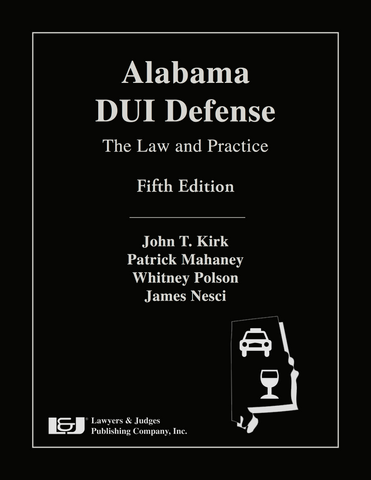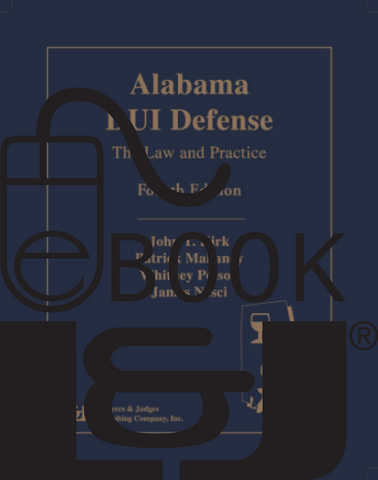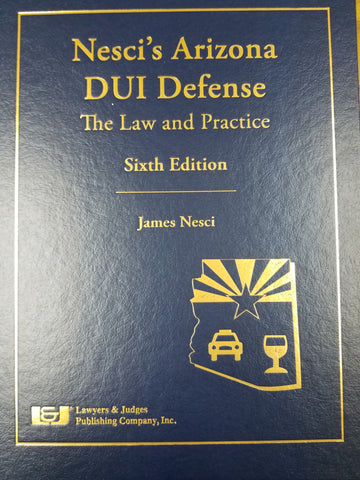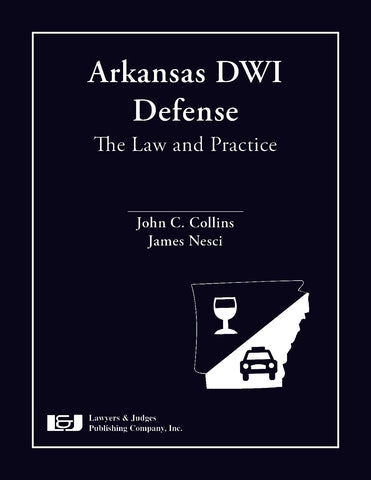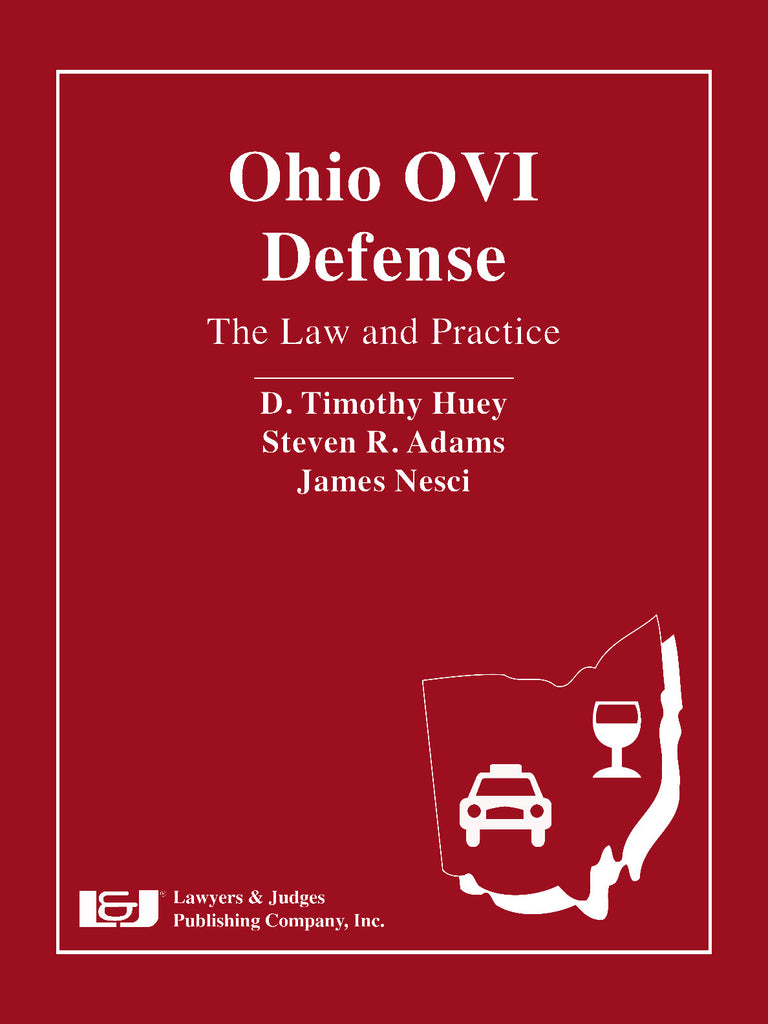
Ohio OVI Defense: The Law and Practice
-
Author: D. Timothy Huey, Steven R. Adams, and James Nesci
- ISBN 10: 1-933264-28-4
-
ISBN 13: 978-1-933264-28-8
-
Copyright Date Ed: May 13, 2016
-
Pages: 672
-
Binding Information: Casebound with DVD
- Size: 8.5 ✕ 11 Inches (US)
For even the most seasoned attorney admitted to practice in the State of Ohio, defending OVI cases has always presented special challenges. Today mounting a successful defense is more difficult than ever. Now you have the advantage with Ohio OVI Defense: The Law and Practice. This text and supplementary DVD contains the most important information to help you attain a successful verdict.
Written by D. Timothy Huey, Steven R. Adams, and James Nesci, members of the National College for DUI Defense, Ohio OVI Defense: The Law and Practice ensures that you understand the chemical, biological and technological concepts and issues underlying OVI prosecution and defense in the State of Ohio. The authors provide the most up-to-date information available on key areas of OVI law in Ohio including: OVI/DUI Investigations, Driving and Field Sobriety Testing, Drug Recognition, Evaluation and Chemical Testing, Blood Alcohol Calculations, Pre-trial Investigations and Motions, Practice, Plea Offers and Agreements, OVI Trial Procedures, and more.
Many practical tools and applications designed to streamline and simplify the complex OVI defense process have been developed along with this book. They are all included on a bonus DVD—so you can locate, review and print them out in a matter of seconds. The companion DVD contains NHTSA studies, articles and visual detection videos, DRE manuals, example forms, and more.
Lawyers & Judges has published twenty state-specific DUI defense reference books. A practitioner in Colorado raved in the Colorado Lawyer that Colorado DUI Defense: The Law and Practice is “a must-have resource” and would make “a nice gift for the lawyers in your life who practice DUI defense.” The Wisconsin Lawyer reviewer gave Wisconsin OWI Defense: The Law and Practice a touchdown review, calling the book “the best book I have read pertaining to Wisconsin operating-while-intoxicated (OWI) law, and one of the best in dealing with the substance of OWI law.”
Book Topics Include:
- Lawyer Advertising
- Client Relations
- Driving Under the Influence
- Bureau of Motor Vehicles
- Pre-Trial Investigations
- Pre-Trial Motions Practice
- Plea Offers
- Trial
- OVI Investigations: Driving and Field Sobriety Testing
- Drug Recognition Evaluation
- Chemical Testing
- Blood Alcohol Calculations for Attorneys
- Expert Witnesses
- OVI Jury Trial Warpack
- List of Ohio OVI and Related Offenses with Statute Numbers
- OVI Sentencing Summary Quick Charts
- Ohio Traffic Rules
- Ohio Rules of Criminal Procedure
- Ohio Rules of Evidence
- Ohio Department of Health Rules for Chemical Testing
- Modern Day Salem Witch Hunts
- The Aging Process and Field Sobriety Tests
- Fear and DWI Field Sobriety Tests
DVD topics include:
- NHTSA Advanced Roadside Impaired Driving Enforcement (ARIDE) Manuals
- Automobile & Motorcyclist Pamphlets
- NHTSA Drug Recognition Expert Course (DRE) 7-Day School
- NHTSA Improved Sobriety Testing
- NHTSA DWI Detection and Standardized Field Sobriety Testing
- Standardized Field Sobriety Testing Validation Studies
- And more!
Table of Contents
Table of Cases
About this Book and How to Use it
Foreword
Chapter 1: Lawyer Advertising
1.1 Ethical Issues in Advertising
ER 7.1 Communications concerning a lawyer’s services
ER 7.2 Advertising
ER 7.3 Direct contact with prospective clients
ER 7.4 Communication of fields of practice
ER 7.5 Firm names and letterheads
1.2 Advertising Resources
A. Phone Book Advertising
B. Internet Advertising
C. Giveaways
D. Television
1.3 Social Media
A. Ethical Concerns
B. Confidentiality vs. Privilege
C. The 3 Tenets of Social Media: Timeliness, Honesty, and Transparency
D. Facebook
E. Twitter
F. Social Media as a Research Tool
G. Final Thoughts on Social Media
Chapter 2: Client Relations
2.1 Meeting the Prospective Client
2.2 Client Intake Questions
2.3 Client Intake Interview
2.4 Representation Agreements
2.5 Fees
2.6 IOLTA
2.7 Communication
2.8 Client File Retention
2.9 Representing the Military Client for DUI
2.10 Pilots and Merchant Marines
2.11 Non U. S. Citizens—Immigration Consequences
2.12 Canadian Travel
Chapter 3: Driving Under the Influence
3.1 Basic Misdemeanor DUI Offenses
3.2 Basic OVI
3.3 Prior Offenses in Misdemeanor Cases
3.4 Seizure of Vehicles Upon Arrest
3.5 Homicide and Assault
3.6 Reckless Operation
3.7 OVUAC Operating a Vehicle after Under Age Consumption
3.8 Physical Control
3.9 Sentencing: Statutory Scheme
3.10 Restitution
3.11 Government Oversight, DUI Abatement and Money
Chapter 4: Bureau of Motor Vehicles
4.1 Overview
4.2 The Administrative License Suspension (ALS) per se/Implied Consent Form
4.3 Procedures for Administrative License Suspension R.C. 4511.192 Text
4.4 Administrative License Suspension: Notice
4.5 Administrative License Suspension Appeal R.C. 4511.197
4.6 Administrative License Suspension Appeal R.C. 4511.197 Text
4.7 Appealing an Administrative License Suspension
4.8 Time Computations
4.9 Pretrial Suspension a.k.a. Public Safety Suspension
4.10 Driving Privileges
4.11 Retraction of Refusal
4.12 Right to Attorney Prior to Taking Chemical Test
4.13 Minors
4.14 Juveniles
4.15 Suspension for Out-of-State Violations
4.16 Out-of-State Licensees
4.17 Commercial Driver’s License Disqualifications
4.18 Commercial Driver License Notification Requirements
4.19 Certified Ignition Interlock Devices (IID)
4.20 Sealing a Criminal Record
Chapter 5: Pre-Trial Investigations
5.1 Overview
5.2 Proper Filing Techniques
5.3 Visiting the Scene
5.4 Photography and Videos
5.5 Diagrams and Aerial Photography
5.6 Accident Reconstruction
5.7 Event Data Recorders (Black Boxes)
5.8 Roadblock (a.k.a. “DUI Checkpoint”) Investigations
5.9 Pre-Trial Interviews, Law Enforcement
5.10 Pre-Trial Interviews, Emergency Personnel
5.11 Pre-Trial Interviews, Civilians
5.12 Prior Offenses
Chapter 6: Pre-Trial Motions Practice
6.1 Overview
6.2 Critical Statutes and Cases
6.3 The Statutory Predicate
6.4 Related Statutes
6.5 Ohio’s Aberrant Interpretation of the Statutory Predicate
6.6 Vega and the Statutory Predicate
6.7 Vega and challenges to the admissibility of the breath test results
6.8 Positive trends regarding Vega and admissibility: The Intoxilyzer 8000 litigation
6.9 Vega and discovery
6.10 Vega and challenging the weight of evidence at trial
6.11 Positive trends related to Vega and challenges at trial
6.12 Tips for dealing with Vega at trial
6.13 State v. French and Defiance v Kretz – unique OVI Suppression Motion issues
6.14 Xenia v. Wallace, State v. Shindler and “particularity” of motions
6.15 Homan and R.C. 4511.19(D)(4) - special rules for Standardized Field Sobriety Test evidence
6.16 State v. Mayl and R.C. 4511.19(D)(1)(a) - special rules for medical blood and urine tests
Chapter 7: Plea Offers
7.1 Overview
7.2 Waiver of Rights
7.3 Collateral Consequences
7.4 Immigration Consequences
7.5 Exposure of Prior Offenses
7.6 Subsequent Offenses
7.7 Equivalent Offenses as Prior Offenses
7.8 Misdemeanor Plea Offers
7.9 Felony Plea Offers
7.10 New Trend: Plea Offers on the Record
Chapter 8: Trial
8.1 Overview
8.2 Voir Dire and Jury Selection
8.3 Jury Instructions
8.4 Opening Statements
8.5 Cross-Examination
8.6 Direct Examination
8.7 Closing Argument
8.8 Sentencing
Chapter 9: OVI Investigations: Driving and Field Sobriety Testing
9.1 Overview: National Highway Traffic Safety Administration (NHTSA)
9.2 Driving Behavior
9.3 Standardized Field Sobriety Testing (SFST) Validation Studies
9.4 Legal Analysis and Summary of the SFST Validation Studies
9.5 Standardized Field Sobriety Test Battery
9.6 Horizontal Gaze Nystagmus (HGN)
9.7 Walk and Turn
9.8 One-Leg-Stand
9.9 Refusal of SFSTs and General Admissibility
9.10 Advanced Roadside Impaired Driving Enforcement (ARIDE)
9.11 Commonly Used Non-Standardized/Validated Field Sobriety Tests
9.12 Videotaping the Driving and Investigation
Chapter 10: Drug Recognition Evaluation
10.1 Overview
10.2 DRE Statutory Law
10.3 Per Se Statutes Comparison
10.4 Impairment Statutes Comparison
10.5 Defenses
10.6 Implied Consent Laws Comparison
10.7 DRE Case Law
10.8 The 12-Step DRE Protocol
10.9 Deconstruction and Analysis of the 12-Step DRE Protocol
10.10 Effects of Various Drugs
10.11 Drug Evaluation Classification Protocol (DECP)
10.12 Drug Evaluation Classification Training Program
Chapter 11: Chemical Testing
11.1 Preliminary Breath Testing
11.2 Law
11.3 Safeguards
11.4 Commonly Used PBT Devices
11.5 Henry’s Law and the Blood to Breath Ratio
11.6 Evidential Breath Testing
11.7 Infrared Light Absorption
11.8 Basic Design and Operation of Ohio’s Machines Intoxilyzer 5000 and 8000
11.9 Intoxilyzer Printouts
11.10 Breath Testing: Methods of Attack
11.11 Calibration
11.12 Ohio Administrative Code Chapter 3701-53
11.13 Statutory Requirements for Admissibility of Breath Test Results
11.14 Blood Testing: From the Vein to the Lab
11.15 Headspace Gas Chromatography
11.16 Blood Testing For Drugs
11.17 Blood Draws: Statutory Admissibility, Sample Preservation and Independent Testing
11.18 Secondary Blood Testing
Chapter 12: Blood Alcohol Calculations for Attorneys
12.1 Blood Alcohol Calculations for Attorneys
12.2 Determining the One-Drink Potential
12.3 Elimination and Retrograde Extrapolation
12.4 White’s Retrograde Extrapolation
12.5 Partition Ratio Conversions
12.6 Unit Conversions
Chapter 13: Expert Witnesses
13.1 Overview
13.2 Pre-Trial Preparation
13.3 Direct Examination of the Defense Expert Witness
13.4 Cross of the State’s Expert Witness
13.5 Direct Examination of the State’s Expert as a Defense Witness
Chapter 14: OVI Jury Trial Warpack
14.1 Actual Physical Control (APC)
14.2 Aggravation
14.3 Appellate Standard of Review
14.4 Arrest
14.5 Authentication
14.6 Blood Draws
14.7 Breath Testing
14.8 Burden of Proof
14.9 Chain of Custody
14.10 Circumstantial Evidence
14.11 Closing Arguments—Ethical Considerations
14.12 Collateral Estoppel in DUI Cases
14.13 Comment of Defendant’s Silence
14.14 Confrontation
14.15 Corpus
14.16 Court Rules
14.17 Credibility of Witnesses
14.18 Destruction of Evidence
14.19 Discovery and Rule 16
14.20 Directed Verdict/Rule 29
14.21 Double Jeopardy
14.22 DRE: Drug Recognition Evaluation Admissibility
14.23 Due Process
14.24 Evidence
14.25 Expert Witnesses
14.26 Field Sobriety Test Admissibility
14.27 Foundation
14.28 HGN
14.29 Impeachment
14.30 Independent Test
14.31 Jurors and Jury Selection
14.32 Jury Deliberations
14.33 Jury Instructions
14.34 Jury Trial Right
14.35 Motions
14.36 Miranda
14.37 Necessity Defense
14.38 Opinion Testimony
14.39 Plea Agreements
14.40 Prior Convictions
14.41 Probable Cause
14.42 Reasonable Suspicion
14.43 Record Preservation for Appeal
14.44 Refusal to Submit to Chemical Testing
14.45 Relation Back
14.46 Replicate Testing
14.47 Restitution
14.48 Right to Counsel
14.49 Roadblocks (a.k.a. “DUI Checkpoints”)
14.50 Speedy Trial Rights
14.51 Searches
14.52 Sentencing
14.53 Discovery
14.54 Voir dire
14.55 Voluntariness of Statements
14.56 Warrants
Appendix A: List of Ohio OVI and Related Offenses with Statute Numbers
Appendix B: OVI Sentencing Summary Quick Charts
Appendix C: Ohio Traffic Rules
Appendix D: Ohio Rules of Criminal Procedure
Appendix E: Ohio Rules of Evidence
Appendix F: Ohio Department of Health Rules for Chemical Testing
Appendix G: Modern Day Salem Witch Hunts
by Mimi Coffey, Esq.
Appendix H: The Aging Process and Field Sobriety Tests
by Mimi Coffey, Esq.
Appendix I: Fear and DWI Field Sobriety Tests
by Mimi Coffey, Esq.
About the Authors
Index

